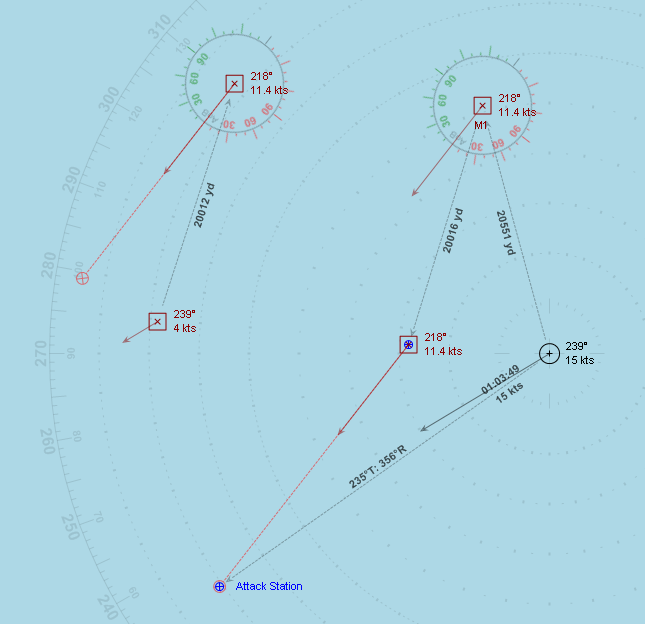Now here's your original example with a little more complexity added. Let's assume we'd like to sneak in for a submerged attack at 4 kts. We need to put our boat in a position where it can make a 4 kt intercept on a target travelling 11.4 kts.
Starting with the original plot...

We know an intercept on the surface at 15 kts is possible. But perhaps this is an armed or escorted merchant. We don't want to just blaze in on the surface at 15 kts.
So we start with a simple what-if scenario off to the side...

Notice I'm just doing a little side calc here to figure out what my station would need to be for a successful 4 kt intercept. I see that a 20k lead and 20° AoB station would allow me to make my submerged approach.
Now I apply what I learned to my plot at the right...

I plot a node for a 20k lead 20° AoB; this represents the relative position that I wish to achieve for target M1.
Now I plot a new contact on the stationing node and set the vector equal to M1 (with the new contact selected, hover over the M1 contact and press "=")

With the new contact plotted, I can determine an intercept point for my desired 4 kt final approach. This is the first leg of the attack, a 15 kt surface run heading 235° for 1:04.
We know once we arrive at that first way point we can submerge and proceed at 4 kts. Oops, I forgot to figure out my final approach heading. Let's do that...

The second leg is a submerged approach at 4 kts, heading 300°. A quick TSD calc on the 300° line reveals that we will be enroute about 45-50 mins before readying to fire. Plenty of time to quietly listen and fine tune our firing solution. Worth noting that you don't actually need to make it all the way to the intercept point on your submerged leg (unless your intention is to ram), so by default you've got a 1000-2000 yds of fluff in there, few extra seconds to double-check that solution.
Now you might also wonder, "Well, I know the distance to the contact was initially over 20k yards, and well out of visual range. But if I start closing that gap on the first leg of my surface run, will I be detected?" Basically, you want to know, "What is the Closest Point of Approach (CPA)?"

The CPA is 16.4k yards. You shouldn't have a problem with visual detection. Notice how you determine CPA in a relative motion plot. It's the point on the target's projected path that is at 90° AoB to OwnShip.
Keep in mind, there are a lot of shortcut keystrokes that can make this a fast plotting process, but it's not unusual for attack plotting to take up a good bit of time. If you like that sort of thing, fine. Others may choose to shortcut the process and just make some estimates.
Edit: Actually, I see I made a common mistake in determining the CPA.

Do you see what's wrong with it?